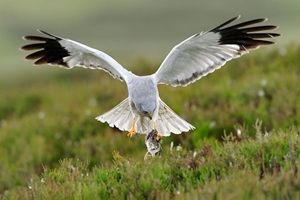 Following its spectacular recovery from no breeding pairs on mainland Scotland in the early 1930s, since the 1980s there has been a broadly stable population of hen harriers in Scotland, fluctuating over time and between regions. In 2004 hen harriers were nationally in favourable conservation status in Scotland according to measures chosen by SNH in a conservation report for the UK’s Joint Nature Conservation Committee. A hen harrier report for SNH is awaited later this year, which will incorporate the results of the latest national survey in 2010. It is expected to show a population of around 500 breeding pairs; lower than the 633 recorded in 2004 but higher than the 436 pairs in 1998.
Following its spectacular recovery from no breeding pairs on mainland Scotland in the early 1930s, since the 1980s there has been a broadly stable population of hen harriers in Scotland, fluctuating over time and between regions. In 2004 hen harriers were nationally in favourable conservation status in Scotland according to measures chosen by SNH in a conservation report for the UK’s Joint Nature Conservation Committee. A hen harrier report for SNH is awaited later this year, which will incorporate the results of the latest national survey in 2010. It is expected to show a population of around 500 breeding pairs; lower than the 633 recorded in 2004 but higher than the 436 pairs in 1998.
The hen harrier population is likely to have increased since 2010, and 2014 in particular has been a good breeding year. For example, at the Langholm Moor Demonstration Project, there have been 12 active hen harrier nests this year compared to 2-3 in previous years, with 46 chicks successfully fledged and ringed in 2014. Other areas in Scotland also appear to have had a good harrier breeding year.
This year’s good hen harrier breeding season may in part be due to benign winter weather and high vole numbers, which are a staple diet of the hen harrier. However, Scottish Natural Heritage (SNH) and raptor experts recognise a range of factors behind the changes in hen harrier breeding numbers, many of which limit their range. For example, there is good evidence that hen harriers are actively excluded from golden eagle hunting ranges. A recent study on Skye, published by the Scottish Ornithologists’ Club, showed that more than half of 88 harrier nests on Skye were predated, two-thirds by foxes.
The SNH hen harrier report is expected to analyse these and other factors when considering what has happened in ten ‘Special Protection Areas’ designated by SNH, mostly in the 1990s when harrier numbers were at a high point. In four of these SPAs, grouse shooting has all but ceased, and that has been matched by a decline in the harrier population. It is probable, as was shown on Langholm Moor in the late 1990s, that the loss of keepering led to more predation by foxes and crows and a reduced food supply for the harriers, and thus contributed significantly to their decline.
But as well as potentially improving hen harrier conservation by reducing predation and increasing food, man’s activities can have a negative impact. Illegal persecution may be affecting recruitment of breeding birds, though there have been few recorded incidents in recent years; in 2013 there were two recorded crimes involving hen harriers. In 2012 two hen harriers were killed after colliding with wind turbines and a recent study supported by the RSPB suggests that the collision risk is greater than previously thought.
All of these challenges mean it would be better if more hen harriers were distributed across Scottish regions in relation to apparently suitable habitat. Central to such sustainable harrier conservation is finding a managed balance between benefits and risks. Heather habitat, abundant food and low predation pressure that benefits harriers are delivered by moorland managed by those who want to shoot red grouse. However, research has shown that there is a real risk as harriers can suppress red grouse numbers below the level where they can be shot sustainably. This conflict is recognised in the Langholm Moor Demonstration Project, which is attempting to find the managed balance between hen harrier conservation and red grouse management and by other conservation approaches being discussed in England.
Image © Laurie Campbell